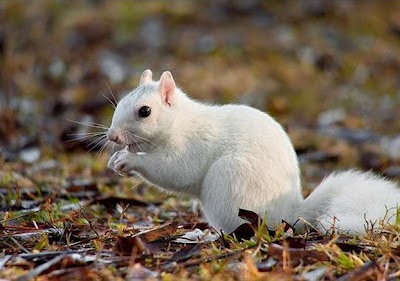Only 10 in every one million squirrels are born with albinism, and have a very short life expectancy because they are easily seen by both predators and prey due to their obvious lack of camouflage.
What we normally think of when we think of squirrels are tree dwelling gray or reddish mammals. Rarely do we imagine their cousins, the ground squirrels (Prairie dogs) or marmots, even though they are in the same family. Nor do we think of squirrels as white! But, there are many places that have white or albino squirrel populations.
Most squirrels are gray or red, an adaptation that allows them to blend in to the surrounding vegetation. Tree trunks are usually a dark color and the mottled gray color of the common forest squirrels. However, several towns across america have claimed to have a large population of white squirrels. How could this be if it is advantageous to blend in with the tree trunks to hide from predators?
This is a case of classic natural selection, the driving force behind evolutionary change. Evolution by definition is the changing of the genetic makeup of a population over time. The trait for being white is a genetic anomalie that is usually weeded out because they are so quickly seen by predators. But today we have a different predator: humans.
Many towns have proclaimed to be the "Home of the White Squirrels," and as a result have started trapping and removing their darker brothers and sisters. What a great example of natural selection that has quickly created a dominant squirrel population that is white.
However, there are other places around the country where white squirrels are popping up and it may not be a result of humans trapping the squirrels. Many places have white stone and white buildings of which white squirrels would be highly adapted too. This small advantage may allow white squirrel populations to spread.

No comments:
Post a Comment